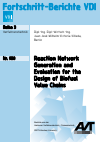Reaction Network Generation and Evaluation for the Design of Biofuel Value Chains
Zusammenfassung
The present contribution addresses engineers and researchers in process systems engineering and computational chemistry. It provides a holistic approach to the design of biofuel synthesis value chains, consisting of several analytic stages. The model-based centers around the generation of reaction networks that head from substrates to desired products. The generation advances in in a formal manner, relying of fundamentals of chemistry, restrictable by empirical knowledge. By investigating the molecular structure of the network intermediates, quantitative statements on the selectivity of network reactions are derived. The networks are decomposed into elementary nodes, non-further decomposable sequences of reactions. Optimization-based techniques are employed to determine optimal synthesis pathways and biofuel blends. The employed evaluation criteria allow for deriving statements on techno-economic performance and network topology.
...
Schlagworte
- I–XVIII
- 1–10 1 Introduction 1–10
- 1.1 The multi-dimensional context of sustainable biofuels
- 1.2 Towards the integration of product and process design
- 1.3 Contribution of this thesis
- 11–54 2 Reaction network generation: Introduction to the basic algorithm 11–54
- 2.1 Reaction network generators - a literature review
- 2.2 Computational representation of molecules
- 2.2.1 Molecules described by character strings
- 2.2.2 Molecules described by graphs
- 2.3 Computational representation of reactions
- 2.4 Formalisms of the reaction generator
- 2.4.1 Valence schemes and valence scheme transitions
- 2.4.2 Combination of valence schemes
- 2.4.3 Computing the adjacency of the non-hydrogen atoms
- 2.4.4 Combining valence schemes and adjacency schemes
- 2.4.5 Equilibrating the formal electric charge of the molecular bodies
- 2.5 Postprocessing of the generated MEs
- 2.5.1 Check for uniqueness
- 2.5.2 Identification of themain reaction product
- 2.6 Reaction network formulation
- 2.7 Workflow of reaction network generation
- 2.8 Conclusions
- 55–65 3 Reaction network generation: Including empirical knowledge 55–65
- 3.1 Restrictions on the transition of valence schemes
- 3.2 Reaction rules
- 3.3 Constraints on the molecular constitution and thermophysical properties
- 3.3.1 Constraining the molecular constitution
- 3.3.2 Restrictions on thermophysical properties
- 3.4 Conclusions
- 66–76 4 Reaction network generation: Network manipulation 66–76
- 4.1 Merging multiple networks
- 4.2 Estimation of the selectivity of reactions
- 4.3 Network reduction
- 4.4 Conclusions
- 77–94 5 Network evaluation strategy 77–94
- 5.1 Optimization-based network evaluation
- 5.2 Multi-stage network evaluation
- 5.2.1 Decomposition of the network into individual pathways
- 5.2.2 Flux balancing in elementarymodes
- 5.2.3 Determination of the optimal flux distribution
- 5.2.4 Integration of intermediate waste streams
- 5.3 Discussion of the evaluation strategies
- 5.3.1 Optimization based evaluation strategy
- 5.3.2 Multi-stage evaluation strategy
- 5.4 Conclusions
- 95–127 6 Case studies 95–127
- 6.1 Defining a reference process
- 6.2 Lignin gasification for hydrogen production
- 6.3 Synthesis of 3-MTHF fromitaconic acid
- 6.3.1 Manually constructed reaction network
- 6.3.2 Automated reaction network generation for 3-MTHF synthesis
- 6.3.3 Evaluation of the reaction network
- 6.3.4 Discussion of the evaluation results
- 6.3.5 Comparison against the reference process
- 6.3.6 Integration of intermediate waste streams
- 6.4 Synthesis of 2-BF and 2-BTHF fromfurfural
- 6.4.1 Reaction network generation for 2-BF and 2-BTHF synthesis
- 6.4.2 Evaluation of the reaction network
- 6.4.3 Discussion of the evaluation results
- 6.4.4 Comparison against the reference process
- 6.4.5 Integration of intermediate waste streams
- 6.5 Conclusions
- 128–131 7 Conclusions and outlook 128–131
- 7.1 Increasing propertymodel detail and accuracy
- 7.2 Design of sustainable value chains
- 7.3 Synthesis design outside the biofuel scope
- 132–169 Appendices 132–169
- A - Mathematical preliminaries
- A.1 Graph theory
- A.2 Set theory
- B - Reactions rules
- C - Triggering and resulting patterns for determining non-selective reactions
- D - Property models
- E - Evaluation criteria
- E.1 Material balance related criteria
- E.2 Economic criteria
- E.3 Environmental criteria
- E.4 Energetic criteria
- F - Case study data
- F.1 Data of 3-MTHF synthesis fromitaconic acid
- F.2 Data of 2-BTHF and 2-BF synthesis fromfurfural
- G - Software availability and handling
- G.1 Software availability
- G.2 Setting up the software environment
- G.3 Setting up a reaction generation task
- 170–186 Bibliography 170–186


